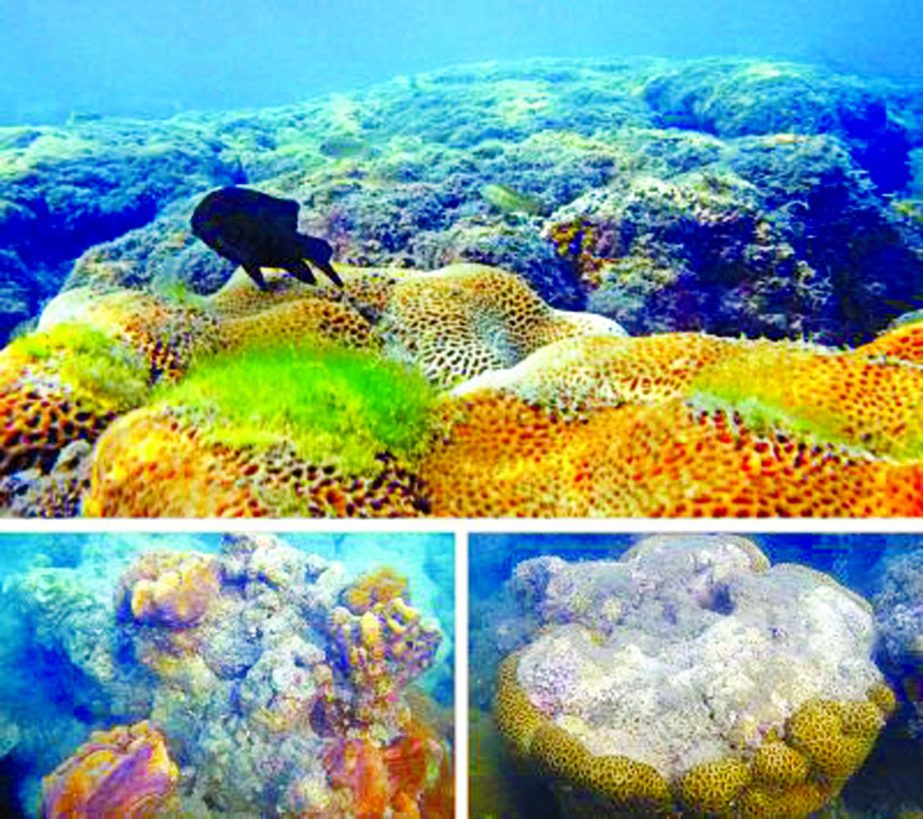
Gazi Anowarul Hoque :Indiscriminate anchoring of tourist boats and fishing vessels is gradually damaging the coral reefs, changing the dynamics along with posing threat to the country’s lone coral Island Saint Martin’s, according to experts.Hundreds of country boats and fishing vessels usually use very sharp metal anchors. While pulling up the anchors, the coral breaks into pieces. Not only that, the fishermen also damage and disturb coral beds to pull out their nets, which get stuck during fishing. The temperature of the Bay of Bengal has significantly increased in the last four decades, raising acidification in the water and destroying many of the 22 species of corals available there. Besides, garbage strewn on shore or dumped into the sea by hotels and tourists near the island is leading to pollution of the sea bed, scientists say. An official of the Department of Environment (DoE) said, the government declared the island as Ecologically Critical Area (ECA) in 1999, but did not take any major initiative to make the declaration effective till the date for lack of manpower. “Attention must be given to the island issue as 25 percent of all marine lives depend on corals. Without coral reefs, fishes would have no place to live and lay their eggs, but most of the corals are ruined for excessive anchoring near the jetty of the island,” Dr Anisuzzaman Khan, a biodiversity expert, who recently dived 22 feet under water around the island, told The New Nation on Saturday. “Many of the corals now appear colourless and dead due to ocean acidification and rise in sea temperature, both linked to global warming, caused corals to expel the algae that are photosynthetic. With the expulsion of the algae, corals lose colour and appear white, which is called coral bleaching,” he said. Govt should declare that Island as Marine Protected Area (MPA). Its implementation should come from Ministry of Environment and Forests and Ministry of Fisheries, he opined. Anisuzzaman suggested that only researchers should be allowed to landing and others can just see the island. Teknaf based tourism infrastructure should be made by the government’s initiative. Meanwhile, a recent research conducted by M Shahidul Islam of the Department of Geography, Dhaka University, indicated that the physical environment of the area is under severe ecological stress and the damages to coral species have now reached an alarming stage. Islam’s research, conducted using scuba diving, found that due to human intervention, out of 10 coral reefs, some have broken-up, damaged or uprooted from their growth position and coral debris is clouding the water. In the last 40 years, about 0.45 degree Celsius temperature has increased, Ahsanuddin, a former reviewer of Intergovernmental Panel on Climate Change, said.Excessive carbon dioxide emission that contributes to climate change also raises acidification in the ocean, although very low, but enough to destroy sensitive corals, he said. SM Atiqur Rahman, Director of a marine conservationist organization-Save Our Sea and ocean explorer said every coral has algae on its upper part which serves food and energy to the coral. When operator of ships lift sediments or mud from seabed and cover the upper part of coral at least half to one inch, algae fail to get sunlight and die, which eventually causes the death of the coral. The reef of Saint Martin is situated in the extreme southern part of Bangladesh, with more than 700 species of seaweed, corals, fish and other marine life forms. Though the island was declared to be an ecologically critical area in 2003, no government agency has made an effort to conserve ecological resources in and around the island. On top of that, growing numbers of tourists are polluting and damaging the natural habitats of many species. Corals occupy less than one percent of the world’s ocean bed, but provide habitats to more than one quarter of the marine wildlife globally.

